Choosing the Right Flowers for Your Hardiness Zone
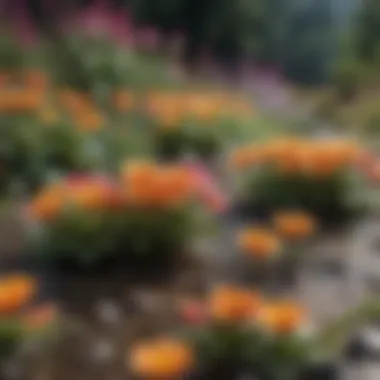
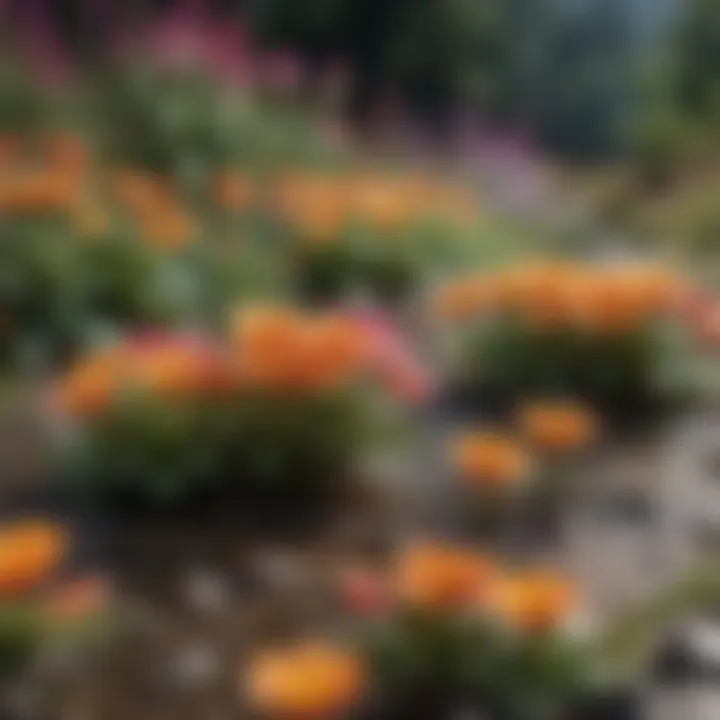
Overview of the Topic
When it comes to gardening, choosing the right flora isn't just a matter of personal taste; it's predominantly dictated by your local climate. The hardiness zone system, which divides regions based on climate conditions, essentially acts as a guiding star for gardeners. This system helps identify plants that thrive well in particular climates. Understanding this concept is fundamental for anyone looking to cultivate a flourishing garden. Consequently, selecting the ideal flowers can transform your garden into a vibrant oasis, reflecting both beauty and biodiversity.
Gardening has evolved from a mere hobby to a critical component of environmental conservation. As climate change poses a significant threat to natural ecosystems, choosing sustainable plant species that align with hardiness zones not only supports personal gardening goals but also contributes positively to the ecological balance. Hence, it's essential to delve deep into understanding how various plant species behave in your specific zone and climate.
Current Status and Challenges
The state of gardening today is both promising and challenging. On one hand, gardeners have access to an unprecedented variety of flora due to global trade and advancements in plant breeding. On the other hand, rapid climatic changes present a unique challenge for plant survival. Some flora once deemed suitable for a region might struggle in shifting conditions.
Factors to consider include:
- Temperature fluctuations: As climates warm, plants in certain zones may experience stress or fail to thrive.
- Pest and disease pressures: Changes in climate can also lead to increased pest activity, impacting plant health significantly.
- Soil degradation: Urbanization and intensive agriculture have depleted many regions' soils of nutrients, adding to the difficulty of maintaining a healthy garden.
Threats to Plant Sustainability
- Invasive species: With global disruptions, many invasive plants thrive where they do not belong, outcompeting native species.
- Water scarcity: Some regions face severe droughts that push the limits of what can be successfully grown.
"Understanding your environment is crucial. What works in one zone might fail spectacularly in another."
Sustainable Solutions
To tackle these challenges, sustainable gardening practices are more important than ever. Here are some strategies that support both plant health and environmental stewardship:
- Native Plant Selection: Choosing native flowers that align with your hardiness zone can lead to a more resilient garden.
- Integrated Pest Management: This approach minimizes chemical use by encouraging beneficial insects and natural deterrents.
- Soil Health Practices: Using compost and cover crops can help rejuvenate soil quality over time.
Various case studies showcase successful implementations of these practices:
- A community garden in Los Angeles, which exclusively planted native flora, reported over a fifty percent increase in local pollinator populations.
- A suburban neighborhood in New York has embraced xeriscaping—a landscaping style that reduces water usage—leading to lower utility bills and increased biodiversity.
Impact and Importance
Gardening is not just a white picket fence affair; it's a critical dialogue with nature. The choices made in our gardens ripple across ecosystems. For instance, selecting diverse flowering plants can lead to healthier local ecosystems through improved pollination and reduced soil erosion. Moreover, it aids in carbon sequestration, which is vital in confronting climate change.
The importance of conservation in gardening practices cannot be overstated. A well-chosen garden nurtures not only the immediate environment but also the broader biosphere, ensuring that future generations inherit a thriving planet. By being mindful of hardiness zones, we create gardens rich with life and sustainability.
Understanding Hardiness Zones
Understanding hardiness zones sets the stage for successful gardening, revealing insights into what plants can thrive in your unique environment. Knowing your hardiness zone allows you to make informed decisions about which flora to select, ensuring a vibrant and healthy garden. This is particularly important for conservationists and environmentalists who are aiming to maintain biodiversity by choosing the right plants that can endure local conditions.
Defining Hardiness Zones
Hardiness zones are geographic areas defined by climate conditions, particularly temperature extremes. The USDA Plant Hardiness Zone Map is a key tool in delineating these zones. It categorizes regions based on their average annual minimum winter temperature, essentially giving a gardener a guideline for what will survive those chilly nights. Zones usually range from number 1, which includes the coldest areas, to 13, representing the warmest climates.
To illustrate, a gardener residing in zone 5 must be cognizant that plants meant for warmer zones—like petunias or salvias—might not fare well in the colder winter months. Conversely, hardy perennials like daylilies or hostas thrive in such conditions. In this way, defining hardiness zones helps in understanding the potential challenges and opportunities when selecting plants.
Importance of Plant Selection
Selecting the right plants based on hardiness zones can lead to a sustainable and flourishing garden. This isn't just about achieving aesthetic appeal; it heavily impacts the longevity and health of your garden. By choosing flora that is well-suited for your specific conditions, you're investing in a lower maintenance garden that requires less intervention like extra watering or fertilizers.
When you plant species that are adapted to your climate, you're also fostering ecosystems that support local wildlife, from pollinators to native birds. Vegetative choices contribute to the overall balance of the local environment, enhancing biodiversity in your area.
"Choosing the right plants is not merely a preference, it's an ethical responsibility towards sustaining our environment."
In summary, grasping the essence of hardiness zones is critical. From the definition of zones to their practical implications on plant selection, understanding this concept will direct your gardening journey, making it not just fruitful but also ecologically sound.
Identifying Your Zone
Understanding your hardiness zone represents a critical first step in the journey towards creating a flourishing garden. The very concept of hardiness zones gives us insight into what plants will thrive in our specific conditions. Rather than merely picking flowers based on aesthetic appeal, identifying your zone allows for a more pragmatic approach to gardening, emphasizing survival and growth capacity in a particular environment. This involves recognizing climate variables such as temperature extremes, soil types, and humidity levels which uniquely affect plant growth. Essentially, by knowing your zone, you're armed with the knowledge to select appropriate flora that aligns with your local climate, providing benefits not only to your garden but also to regional biodiversity.
Using USDA Plant Hardiness Zone Map
The USDA Plant Hardiness Zone Map serves as an indispensable tool in horticulture. It categorizes regions by their climatic conditions, mainly focusing on the lowest average winter temperatures. In many cases, people might glance at the map and see just shades of color, but the real magic lies in understanding what these colors represent.
A simple glance isn't enough; you might find yourself deliberating over whether your garden is in a Zone 5b or Zone 6a. Such nuances matter. For instance, selecting a flower that thrives in Zone 5 while planting in a Zone 6 area could lead to insufficient growth or outright failure of the plant. Moreover, this map is regularly updated to reflect climatic shifts, and with today’s erratic weather patterns, staying abreast of these changes could be crucial for any committed gardener.
"Falling short in identifying your zone can lead to frustrated efforts and wasted resources."
Local Climate Impact
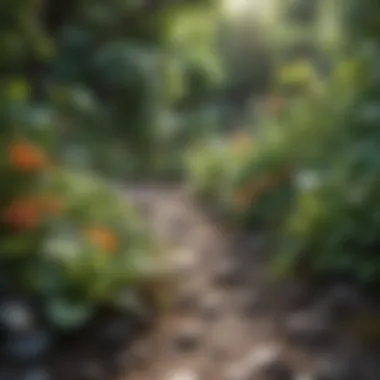

Local climate capsules the essence of your gardening experience. Differentiating local weather phenomena, seasonal variations, and micro-environments within your area significantly steers the success of your floral choices. You might be living in a ‘general’ hardiness zone, but localized factors—like being on a hillside versus a valley—alter conditions dramatically.
For instance, urban areas may produce heat islands, affecting local temperatures and influencing which plants flourish. On the other hand, shaded woodland patches could lead to surprising variations in humidity and light, thereby impacting your plant choices. This is why, in addition to consulting the hardiness map, it’s prudent to observe your immediate environment. Keeping a close eye on how sun exposure and wind patterns shift can unearth a treasure trove of insights about what thrives in your garden.
Microclimates and Their Significance
Microclimates, those tricky little pockets of specific climate conditions within larger areas, are often overlooked yet play a pivotal role in gardening strategy. They can alter temperature, humidity, and even soil characteristics on a small scale, making them crucial for plant selection. Imagine a cozy nook beside your home that receives afternoon sun—a prime site for growing heat-loving flowers.
Conversely, a shaded spot under a large tree could be ideal for more shade-tolerant varieties, or perhaps those that relish damp soils. Recognizing your microclimates allows for maximized prosperity of your flora selection. Each distinct area, from a windy corridor to a still pond-side, offers opportunities and challenges to potential gardeners.
As you prepare to delve further into the fascinating nuances of flower selection, remember that understanding your hardiness zone is foundational. It shapes not only the aesthetic aspects of your garden but guarantees its endurance for seasons to come.
Factors Influencing Flower Choices
When it comes to selecting the right flowers for your garden, understanding the factors that influence flower choices is paramount. This consideration goes beyond mere aesthetics; it taps into the very essence of what makes a plant thrive in its environment. By evaluating aspects like soil type, water availability, sunlight requirements, and climate variations, gardeners can make informed decisions that lead to flourishing and sustainable gardens. Not only does this lead to better plant health, it also reduces environmental strain by minimizing the need for artificial interventions.
Soil Type and Quality
Soil plays a crucial role in the success of any garden. The type of soil—be it sandy, clay, loamy, or silty—significantly affects the availability of nutrients and water retention capabilities. For instance, sandy soils drain quickly but may lack the nutrients necessary for growth, while clay soils, though nutrient-rich, can become waterlogged. Thus, knowing your soil's basic characteristics can guide your flower selection.
Testing soil pH is another important factor. Most flowers prefer a neutral pH, but there are exceptions like azaleas which thrive in acidic soil. If your soil needs improvement, consider adding organic matter such as compost. This not only enhances soil quality but also promotes beneficial microbial activity, turning your garden into a mini-ecosystem.
Water Availability
Water is the lifeblood of any garden. Understanding your garden's water availability can influence your flower choices immensely. Some flowers are drought-resistant, like lavender and sedum, making them perfect for areas with limited water resources. Others, such as begonias and ferns, thrive in moist conditions and may require more frequent watering.
Consider your watering options—whether you’ll be relying on rainfall, drip irrigation, or a sprinkler system. If you have a reliable water source, you might opt for blooms that require consistent moisture. Conversely, if your climate is typically dry, focus on low-water species that can adapt to arid conditions without much fuss.
Sunlight Requirements
The primary source for energy in plant life is sunlight, making it a non-negotiable consideration when selecting flowers. Each plant has its own sunlight needs: some prefer full sun—at least six hours a day—while others thrive in partial or even full shade. Choosing the wrong location can hinder growth and lead to a disappointing garden.
Evaluate your garden's sunlight levels at different times of the day. Consider obstacles like trees or buildings that may cast shadows. Make use of native plants, which often have better adaptation to local light conditions than exotic species. Correctly matching sunlight needs with location can spell the difference between a vibrant garden and a lackluster patch of wilted leaves.
Climate Variation and Trends
Lastly, it is necessary to stay attuned to climate variations and trends that can impact the suitability of flower choices. Weather patterns—like temperature swings, rainfall levels, and seasonal shifts—are essential data points that inform gardeners about potential challenges and opportunities.
For instance, a rise in average temperatures may indicate a need for flowers that can tolerate heat stress, while changing precipitation patterns could necessitate drought-tolerant selections. Being aware of long-term climate trends can lead to a proactive gardening approach, allowing you to select flowers that will thrive not just now, but well into the future.
Select your flowers wisely, considering all these factors, and your garden will become an oasis of beauty and sustainability.
In essence, understanding these factors will equip you with the knowledge to choose flowers that not only beautify your space but also thrive harmoniously with the conditions present in your garden.
Best Flowers for Different Zones
Choosing flowers that align well with your specific hardiness zone is not just a matter of aesthetics; it’s about ensuring that your garden thrives. Selecting plants suitable for the climate conditions you experience can lead to healthier growth, vibrant blooms, and ultimately a more sustainable garden. It’s essential to consider not only the visual appeal of flowers but their adaptability to factors like temperature ranges, sunlight, and soil conditions prevalent in your area. This tailored approach can maximize biodiversity and enhance the ecological balance of your garden, which is particularly appealing to conservationists and environmentalists alike.
Flower Selections for Cool Zones
Cool zones, typically classified as hardiness zones 1 through 4, present a unique set of challenges for gardeners. Here, temperatures can often plummet, frost may linger longer into the spring, and the growing season can be quite short. Yet, there are heartwarming floral selections that not only tolerate these frosty conditions but actually thrive in them:
- Hellebores: Commonly known as Lenten roses, these resilient plants bloom in late winter to early spring. The blooms are often exquisite, with colors ranging from deep plum to soft pastels, providing a much-needed burst of color when the landscape is still largely grey.
- Snowdrops: These tiny white flowers are often one of the first to push through the snow. Their adaptability and ability to bloom in cold conditions make them a favorite among cold-weather gardeners.
- Primulas: These cheerful flowers come in a multitude of colors and can even bloom early in the spring, often through snow. They thrive in both sun and partial shade, making them flexible in planting locations.
In these cooler climates, focusing on early bloomers can help maximize the limited growing season, while also providing early food sources for pollinators emerging from their winter slumber.
Floral Favorites for Mild Zones
Mild zones, which include zones 5 to 7, are often considered favorable for a wide variety of flowering plants. These zones experience mild winters and warm summers, allowing for diverse selections:
- Lavender: Not only does this aromatic herb look stunning, but it also attracts beneficial insects and thrives in sunny, well-drained soil.
- Coreopsis: Known for their bright yellow blooms, coreopsis plants are hardy perennials that love full sun and can bloom all summer long, adding continuous color to landscapes.
- Echinacea (Coneflower): These hardy flowers come in shades of pink, purple, and white. They are drought-resistant once established, making them an eco-friendly choice.
By integrating these floral favorites, gardeners can enjoy a vibrant bloom schedule, extending the visual appeal of their gardens from spring into fall.
Optimal Blooms for Warm Zones
Warm zones encompass regions categorized as zones 8 to 10. These areas boast hot summers and mild winters, which opens the door to a wealth of blooming plant options:
- Hibiscus: With large, showy flowers, hibiscus is a popular choice. Its tropical feel brings a piece of paradise to any garden.
- Salvia: There are numerous varieties of salvia, many of which are heat and drought-resistant. They provide vibrant colors and draw in pollinators like bees and butterflies.
- Rudbeckia (Black-Eyed Susan): Hardy and often blooming in golden yellows and deep oranges, these flowers bring warmth and cheer to any garden.
Warm zones allow for an extended growing season, which means that gardeners can enjoy a dazzling palette of flowers almost year-round.
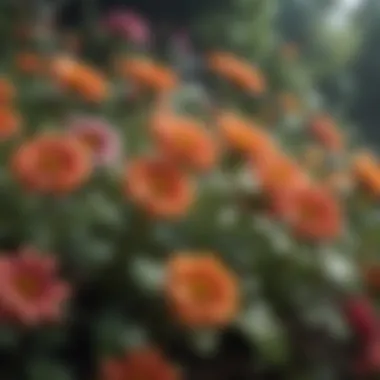

Tropical Choices for Southern Zones
Southern zones, predominantly zones 10 and 11, embody a tropical climate that welcomes an array of exotic plants. Gardeners in these areas should consider:
- Bougainvillea: Known for their stunning, vibrant bracts, bougainvillea is a showstopper. They thrive in full sun and can cover walls, fences, and arbors beautifully.
- Bird of Paradise: This striking plant resembles an exotic bird and can reach impressive heights. It thrives in vibrant sunlight and adds a dramatic flair.
- Plumeria: Also known as frangipani, this shrub produces fragrant flowers that are often used in leis. It thrives in warm climates and requires well-drained soil to flourish.
When selecting flowers for these southern zones, gardeners can truly embrace a tropical aesthetic while ensuring plants are well-suited to withstand both heat and humidity.
Tips for Successful Planting
When it comes to establishing a flourishing garden, the groundwork's quality and proper timing can make or break your efforts. Planting without a thought for soil conditions, seasonal changes, or unexpected weather disruptions is like trying to build a house on sand; you'll likely find yourself in a heap of trouble. This section discusses the pivotal aspects of successful planting, how to prepare your garden bed, timing your planting, and how to respond to the whims of weather.
Soil Preparation Techniques
The foundation of any vibrant garden lies beneath the surface — literally. Soil plays a vital role in the health of your plants. Before diving into planting flowers, take the time to nurture the soil.
- Testing the Soil: First off, ascertain the soil's pH and nutrient composition. You can do this with a commercial test kit available at garden centers. Aim for a neutral pH if you're uncertain. Knowing what you have in your soil means you can make proper amendments.
- Amending the Soil: Depending on the results, your soil could need some enriching. Organic matter such as compost or well-rotted manure can work wonders for drainage and nutrient content. When mixed in properly, it breathes life back into tired soil.
- Tilling Properly: Turn over your soil to aerate it. This not only helps clay-like soils but ensures that your flower's roots can spread out with ease. However, don't go overboard on the tilling — extreme disruption can kill beneficial microorganisms.
So, don't shortcut your soil prep. A little elbow grease here pays dividends down the line, often leading to robust, blooming flowers that bring joy.
Optimal Planting Timeframes
Timing is everything in gardening. Generally, the best window for planting flowers is hinged on your hardiness zone and seasonal temperature trends. Knowing when mother nature plays ball will determine your success.
- Spring Planting: Many bloomers thrive when planted in early spring, as they need moderate warmth to sprout. Aim to plant after the last frost. This is often when both soil and air temperatures start to warm.
- Fall Planting: Quite a few varieties, especially perennials, can thrive if planted during the fall. The roots have ample time to establish before winter sets in. Just keep in mind to check dates for your specific zone to avoid subjecting new tender shoots to frost.
- Timing Specifics: Always keep your eye on the weather report. A warm autumn day can fool you into thinking it’s time, but frigid forecasts might snatch your new planting away. This sort of awareness will help protect your garden from being overambitious while also taking advantage of the right conditions.
Inclement Weather Considerations
Weather can be fickle, and gardening is no exception. Understanding how to cope with unexpected changes can help preserve your investment of time and effort.
- Heavy Rain: After a deluge, check your newly planted areas. Waterlogged roots can quickly lead to rot. If you sense issues, you might need to literally dig some plants up until water drains properly.
- Frost Alerts: Always keep a lookout for late-season frosts, especially in the spring. A cloth cover can act as a barrier when temperatures drop unexpectedly. This simple method can safeguard tender blooms and young plants against frost damage.
- Heatwaves: Conversely, during blistering summer days, don't let your flowers Dry Out like a desert. Water in the cool parts of the day and consider mulching to retain moisture around roots.
"No matter how well you plan, expect the unexpected. Mother Nature has her own agenda, and it's up to us to adapt."
Taking these considerations into account will help you navigate the gardening terrain better, preserving your efforts and plants under varying conditions. By investing time in knowing your soil, timing your planting right, and preparing for inevitable weather hiccups, you'll set the stage for a successful bloom.
Caring for Your Garden
When you prioritize garden care, the following elements become crucial:
- Proper water management
- Thoughtful fertilization techniques
- Vigilant pest and disease oversight
These factors contribute immensely to the health and vibrancy of your garden. Neglecting any of these areas can lead to underwhelming results, even if the plant species chosen are well-suited to the hardiness zone. Returning to the roots of effective gardening practices is critical for creating a lasting floral display.
Watering Strategies
Watering is akin to the lifeblood of your garden. Plants in different hardiness zones have unique hydration needs. Many gardeners underestimate how crucial it is to understand the quantity and frequency of water plants require. Overwatering can drown roots, while underwatering can lead to stunted growth or wilting.
A handy strategy is to adopt a consistent watering schedule, ideally early in the morning or late in the afternoon. During this time, you can harness the cooler temperatures, reducing water evaporation. Other techniques include:
- Drip irrigation: This method delivers water directly to the plant’s roots, minimizing waste.
- Soaker hoses: Lay these hoses along your plants for slow, deep watering.
- Mulching: This conserves soil moisture by creating a barrier against evaporation while suppressing weeds.
Remember, it's often more about the quality of watering than the quantity.
Fertilization Practices
Applying fertilizers is essential for revitalizing depleted soil and ensuring plants receive vital nutrients. However, indiscriminate use can cause more harm than good. Knowing when and how to fertilize significantly varies among plant species.
Organic fertilizers often serve as a beneficial option, promoting long-term soil health without the harsh effects of chemical fertilizers. It’s also wise to conduct soil tests to understand nutrient deficiencies. Key practices include:
- Timing: Fertilize your flowers at the start of the growing season. This helps in faster establishment and more robust growth.
- Method: Broadcasting, foliar feeding, or using slow-release options ensures that plants have continuous access to nutrients.
- Observation: Look for signs of nutrient deficiencies, such as yellowing leaves or poor bloom production. This helps adjust fertilization accordingly.
Pest and Disease Management
Garden pests can be akin to uninvited guests, showing up unannounced and wreaking havoc. Effective pest management requires a proactive approach. Identify potential threats early and develop a good understanding of your local pest populations.
Preventative measures can save you a lot of headaches down the line. Integrated Pest Management (IPM) strategies focus on combining natural methods with chemical solutions when necessary. Here are some methods to consider:
- Encourage beneficial insects: Lacewings and ladybugs can help keep pest populations in check.
- Crop rotation: This not only helps prevent soil-borne diseases from establishing but also confuses pests.
- Identify disease symptoms early: Spotting wilting leaves, unusual spots, or stunted growth early is crucial in addressing the issue swiftly.
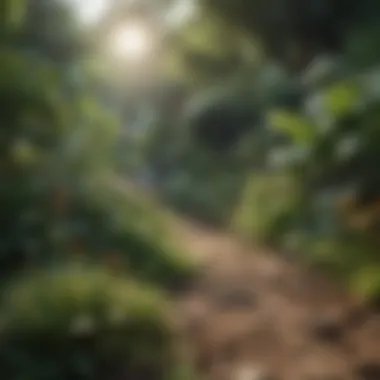

Through diligent care, you can ensure your garden not only thrives but also contributes positively to the surrounding ecosystem. Through effective watering, strategic fertilization, and vigilant pest management, you’re setting the stage for a robust floral display that enhances not just your environment but offers a sanctuary for local biodiversity.
Sustainable Gardening Practices
Sustainable gardening is not just a buzzword; it's a vital approach that resonates with the link between environmental health and gardening efforts. Understanding this importance can pave the way to not only beautifying space but also nurturing the planet itself. When we speak of sustainable gardening practices, we refer to methods that work in harmony with local ecosystems. This approach significantly reduces resource consumption and encourages biodiversity. It's not merely a trend; it's about cultivating a lifestyle that respects our resources while still allowing us to create beautiful areas.
Utilizing Native Plants
What’s better than utilizing plants that already call your region home? Native plants are adapted to the local climate, soil, and wildlife, which inherently makes them resilient and low-maintenance. They require less water and can withstand local pests, so the need for pesticides is greatly diminished.
By bringing native flora into your garden, you contribute to your local ecosystem in several ways. Birds, bees, and butterflies can find refuge and food sources, making your garden a vital part of their lifecycle. Additionally, many native species thrive in their natural environment without the need for fertilizers or excessive care, beckoning a more effortless gardening experience.
To kick-start your native plant journey, consider joining local gardening clubs or utilizing resources such as your regional extension office. Their expertise is invaluable for matching local flora with your gardening goals.
Companion Planting Strategies
When considering plant relationships, companion planting can be a game-changer in your pursuit of sustainable gardening. This method involves pairing plants that mutually benefit each other. For example, a classic combo is the planting of tomatoes along with basil and marigolds. While basil can enhance the flavor of tomatoes, marigolds attract beneficial insects that help manage pests.
The beauty of companion planting lies in its natural ability to manage pests and promote plant health, minimizing the need for chemical interventions. It's also a smart way to maximize garden space—different plants grown together can often harness resources more effectively. Make sure to research various plant combinations suitable for your specific zone, allowing your garden to flourish while reducing competition and pest pressure.
Water Conservation Techniques
Water is a crucial element in gardening, and conserving it should be at the top of every gardener's list. Implementing effective water conservation techniques can help ensure that every drop counts. First and foremost, mulching is an underrated practice. Applying organic mulch around plants retains moisture, reduces evaporation, and suppresses weeds, which can steal precious water.
Additionally, consider installing water-efficient irrigation systems, like drip irrigation. This method delivers water directly to the plant root zone, minimizing loss through evaporation or runoff. When it rains, capturing rainwater in barrels can provide an excellent resource for irrigation, reducing reliance on municipal water sources.
To optimize water usage even further, it’s key to plant native and drought-resistant species, which are often better adapted to withstand periods of dryness. This not only conserves water but also fosters healthier plants that require less maintenance.
"Adopting sustainable gardening practices fosters a relationship between the gardener and the environment, leading to a more resilient ecosystem."
Incorporating these sustainable gardening practices into your routine can transform your gardening experience while positively impacting the planet. It’s a holistic approach that aligns plant selection with ecological responsibility, creating gardens that are as functional as they are beautiful.
Closure and Future Considerations
In closing, the choices we make about the flora in our gardens extend beyond aesthetics. Understanding the implications of our selections is essential for both personal fulfillment and ecological balance. This section emphasizes the need for long-term planning in our gardening endeavors while also addressing the pressing challenges posed by climate change. With both considerations, a thoughtful approach allows for gardens that not only thrive but also contribute positively back to the environment.
Long-Term Floral Planning
When we talk about long-term floral planning, it’s vital to consider what flowers will not only bloom beautifully today but will also adapt to the changing conditions of tomorrow. Plants are not static; they interact with their environment and can be influenced by factors like soil nutrient levels and climate shifts. Here are some steps for effective long-term floral planning:
- Assess your zone: Regularly check the USDA Plant Hardiness Zone Map as zones can shift slightly over time due to climate changes.
- Select diverse species: By choosing a mix of perennials, annuals, and biennials, one can create a resilient garden that endures various climate conditions.
- Emphasize native plants: Native flora are often more equipped to withstand local environmental stresses. They require less care and provide habitats for local wildlife.
In essence, this anticipatory strategy can lead gardeners to not just grow flowers, but to foster ecosystems resilient to the evolving climate.
Addressing Climate Change Challenges
Climate change is no longer a distant worry; it is a present-day reality affecting how plants grow and thrive. As temperatures rise and precipitation becomes increasingly erratic, adapting our gardening strategies is crucial. Here are several approaches to consider:
- Monitor changing weather patterns: Keeping an eye on seasonal changes can inform choices about when to plant or when to expect blooms.
- Implement water conservation techniques: With droughts becoming more common, using drip irrigation and rainwater collection can diminish the impact on local water resources.
- Engage in community efforts: Joining local gardening groups focused on sustainable practices can provide insights on how others are navigating these new challenges.
"The best time to plant a tree was twenty years ago. The second best time is now." – Chinese Proverb
In summary, by engaging in long-term floral planning and actively addressing the challenges posed by climate change, we not only nurture our personal spaces but contribute to a broader ecological balance. Every flower chosen today can have a ripple effect on future generations, making our gardens not just a collection of plants but living legacies that honor the resilience of nature.
Further Resources for Gardening Enthusiasts
In the realm of gardening, especially when it comes to selecting the right flora for one’s hardiness zone, knowledge is power. Accessing the right resources can significantly enhance your gardening experience, offering guidance and fostering a deeper understanding of plant ecosystems. Here, we’ll explore some valuable resources that cater to various interests—from literature that dives deep into horticultural science to online communities that provide real-time support.
Books and Publications
Books related to gardening act as treasure troves of information. They not only provide foundational knowledge but also cover the nuances of plant selection, soil types, and regional specifics. Below are some recommended titles:
- The Garden Primer by Barbara Damrosch: A comprehensive guide that covers a wide array of gardening topics, making it suitable for both novices and seasoned gardeners.
- Flora of North America: This multi-volume series gives detailed descriptions of native plants and their habitats, which is essential for those wanting to utilize native species in their gardens.
- Planting: A New Perspective by Piet Oudolf and Noel Kingsbury: Great for those interested in landscape design and how to create beautiful plant combinations.
Having access to well-researched books enhances your ability to make informed decisions about floral selections tailored to your hardiness zone. Whether you need to understand seasonal growth patterns or specific pest management techniques, these publications will serve as a solid foundation.
Online Platforms and Communities
In today's digital age, online platforms have become invaluable for gardeners seeking advice and inspiration. These communities provide a space to share experiences and gain insights from others facing similar challenges. Notable examples include:
- Reddit: Subreddits like r/gardening offer a collaborative environment where gardeners share tips, ask questions, and post updates about their plants. It’s a goldmine for real-world advice.
- Facebook Groups: Many local gardening groups exist, fostering community connection among members who can discuss zone-specific plants and share local resources.
- YouTube Channels: Channels such as Garden Answer provide visual tutorials and tips on planting and maintaining flora, allowing for a more hands-on understanding of gardening practices.
Engaging in these online circles can build confidence and spark creativity. Being part of a community where you can share struggles and victories cultivates a sense of belonging, further enriching your journey in sustainable gardening.
"The more you know, the more you grow—both your garden and your understanding."
Looking at the resources available can directly impact your gardening results. By exploring literature and connecting with like-minded individuals online, you can deepen your grasp on how to select flowers that will thrive in your specific conditions.



